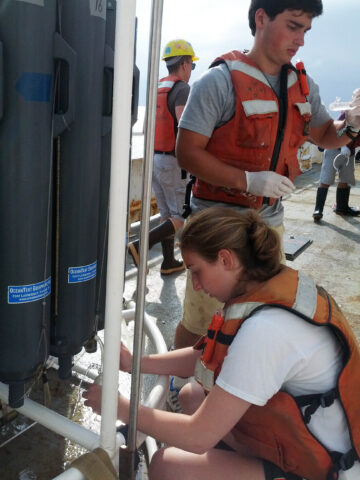The mighty Hudson Canyon stretches 650 kilometers (400 miles) southeast from the mouth of the Hudson River, cleaving the continental shelf south of Long Island. Here, about 500 meters below sea level, methane bubbles up from the seafloor into the ocean. New research reveals that microbes here rapidly consume much of this greenhouse gas before it ever reaches the atmosphere.
“What’s surprising was how quickly the methane was being oxidized.”
In many ocean waters where methane is found, there are microbes oxidizing it for energy, and this short stretch of Hudson Canyon is no exception. “What’s surprising was how quickly the methane was being oxidized here,” said John Kessler, a biogeochemist at the University of Rochester in Rochester, N.Y. He and his colleagues have found that microbes in the water near the seeps may consume up to 80% of the released methane in a matter of days to weeks.
That’s among the fastest consumption rates that scientists have observed at other seep fields, Kessler said. He and his colleagues are currently investigating the various factors that might contribute to the high rates, including availability of trace metals, oxygen, and methane. Kessler presented the team’s findings at the 2015 American Geophysical Union Fall Meeting on 16 December in San Francisco, Calif.
Escape from Hydrates
Methane in the Hudson Canyon site most likely escapes from methane hydrates—ice-like cages of water molecules that trap methane gas. These form at low temperatures and high pressures, but the cages disintegrate as they warm, releasing methane into the water. Alternating warm and cool currents may seesaw Hudson Canyon hydrates between methane capture and release.
“It’s a really interesting place because we didn’t know until recently the precise location of the seeps there,” said Carolyn Ruppel of the U.S. Geological Survey in Woods Hole, Mass., who helped discover more than 570 methane seeps along the U.S. Atlantic margin based on data from a 2011–2013 expedition. “They’re at a very provocative water depth, right at the edge of hydrate stability,” Ruppel noted.
Collecting from the Canyon

In July of 2014, Kessler led a research cruise to Hudson Canyon to track the fate of the methane. Ruppel and Thomas Weber of the University of New Hampshire in Durham pinpointed the seeps using sound waves that bounced off methane bubbles. The team sailed the National Science Foundation’s research ship R/V Endeavor over the seep field, along a 6-kilometer (3.7-mile) stretch of the canyon, and collected water samples at varying depths using sensors that simultaneously measure conductivity, temperature, and depth of ocean water, known as CTD rosettes.
The U.S. Atlantic Margin is an important new site for methane exploration, said Dave Valentine, a biogeochemist at the University of California, Santa Barbara, who had two of his lab members on Kessler’s cruise. “Compared to California and the Gulf of Mexico, we know so little about seepage here,” he said. “It’s important to understand the microbial response in this less geologically active setting.”
Lab Confirmations
Back at the lab, the researchers confirmed that Hudson Canyon seeps release a significant amount of methane. In some of the water samples, they measured changes in the proportions of methane molecules with different carbon isotopes. Those proportions can vary depending on how much methane has been oxidized. In other samples, they introduced methane with a specific carbon isotope and tracked how much was broken down by microbes. They also turned to wine for inspiration—but not in the way you might think.
In the lab, microbe populations take just a few days to become established before aggressively consuming methane.
Bags used for boxed wine combine the cleanliness of plastic with a metallized outer layer that keeps gases out. The scientists teamed up with a beverage company to make custom incubation bags, in which they grew the Hudson Canyon microbes in carefully preserved natural conditions. In the bags, microbe populations took just a few days to become established before aggressively consuming methane. Water samples collected away from the seeps took twice as long to establish a thriving population. Further studies will explore why the consumption rates are so high in a seep environment.
Acidity Mystery
When microbes oxidize methane, they produce carbon dioxide and increase ocean acidity. This is similar to the way in which carbon dioxide produced by humans increases acidity (lowers pH) at the surface of the ocean, disrupting marine ecosystems. Kessler and his team found a decline of 0.1 pH unit between water outside of Hudson Canyon and the seep field inside it—the same decline reported for surface waters because of human activity.
“When we first looked at that, we said, ‘Oh my gosh, we’re burning the candle on both ends,’” Kessler said. But they found that not enough methane oxidation occurs to explain the observed decline, despite the high rates.
“There’s just not enough methane,” Kessler said. Instead, something else must be oxidized in those deep waters, perhaps dissolved particulate carbon or methane from outside the seep field.
Methane Along the Margin
The study of methane oxidation in Hudson Canyon and along the rest of the U.S. Atlantic Margin is just getting started, Kessler said. “Our knowledge is far from complete, and more research is needed to determine why [methane oxidation] is so rapid in this region, if similar results can be expected elsewhere, and ultimately the global impact of methane release from hydrates,” he said.
—Sarah Stanley, Freelance Writer, email: [email protected]
Citation: Stanley, S. (2015), Microbes make a quick meal of methane in a submarine canyon, Eos, 96,doi:10.1029/2015EO042425. Published on 28 December 2015.
Text © 2015. The authors. CC BY-NC 3.0
Except where otherwise noted, images are subject to copyright. Any reuse without express permission from the copyright owner is prohibited.

